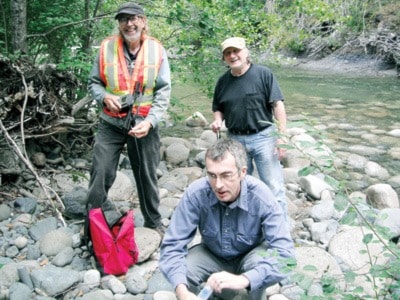How’s the water?
That’s a question Faye Smith and her team hope to be able to answer.
The group, made up of members of the Mid Vancouver Island Habitat Enhancement Society (MVIHES), the Regional District of Nanaimo (RDN) and technicians from the Ministry of Environment, was knees-deep in the Englishman River recently to test the water quality in a program to monitor the quality of several local watercourses.
“The idea is to do water quality monitoring in a number of rivers in our area on the same day,” Smith said. “They were particularly looking for rivers that had stewardship groups.”
The Stewardship Group Water Quality Network Monitoring is an area-based planning program sponsored by the RDN, the Ministry of Environment (MOE) and local stewardship groups to assess the effectiveness of water management within the RDN, as well as impacts to watershed health. The information will be used to guide watershed priorities and planning for the future.
“We need to have a better understanding of the watersheds in order to protect and maintain good water quality for all uses of water — drinking, recreation, irrigation, aquatic life and wildlife,” Smith said.
The team, she said, was testing for turbidity — the amount of suspended particles in the water — as well as for temperature, conductivity and the amount of dissolved oxygen available.
“That tells quite a lot about the general conditions of the water,” Smith said. “Turbidity was chosen as one of the parameters to measure because it can be associated with several different land uses, such as urban development, agriculture and forestry.”
The monitoring is being conducted on five days over 30 days of monitoring in the low-flow period. That’s just the first part of the program, however.
The monitoring, she said, is set to be conducted twice per year, once in the low flow and once in the high flow periods, in order to get an idea of the general state of the rivers involved.
Four watersheds have been included in the program this year, including the Englishman River, Little Qualicum River, French Creek and Nile Creek. All of these watersheds have local stewardship groups that are doing the monitoring.
The RDN is co-ordinating the sampling as well as providing the monitoring instruments. The Ministry of Environment provides technical expertise and has trained the groups in monitoring methods.
The program began on August 16, when members of MVIHES sampled six sites in the Englishman River watershed: at the orange bridge, in the Regional Park, on Morison Creek, upstream of Morison Creek confluence, South Englishman and 15km above Highway 19 at Northwest Bay Division entrance.
The water monitoring program was slated to continue for four weeks.
“Although these low flow summer excursions are more fun than a picnic, we can expect some not so nice weather for the next set of five tests starting October 18, but our volunteers never complain,” she said. “In fact, we all enjoy being on the river at any time and are pleased to be doing something that will help to protect it for the future.”
news@pqbnews.com
